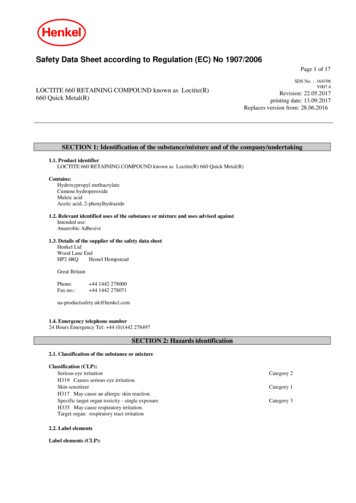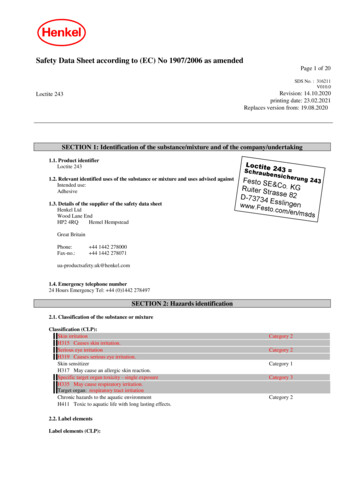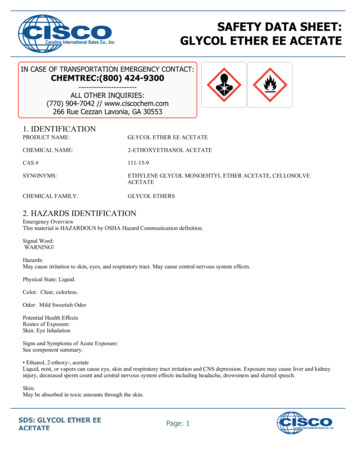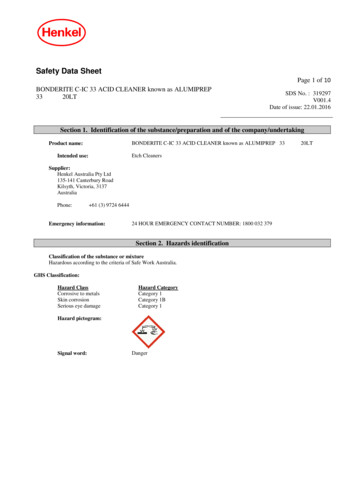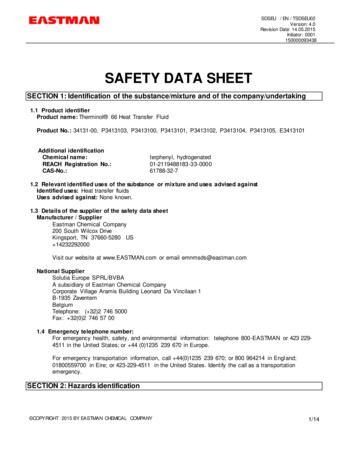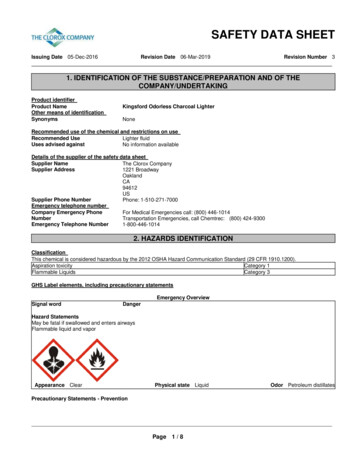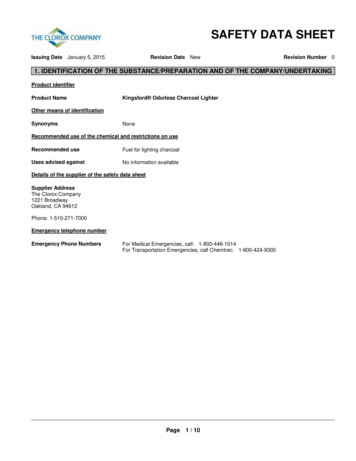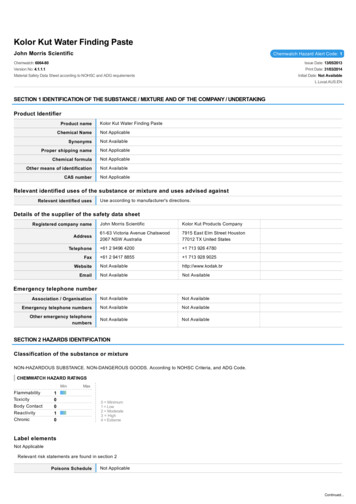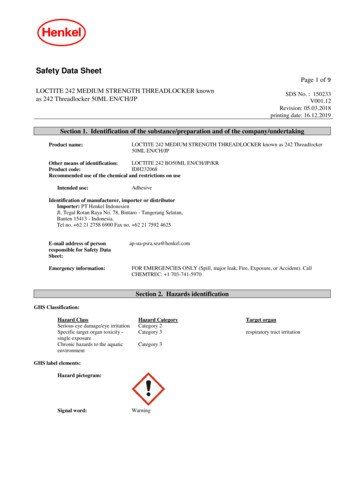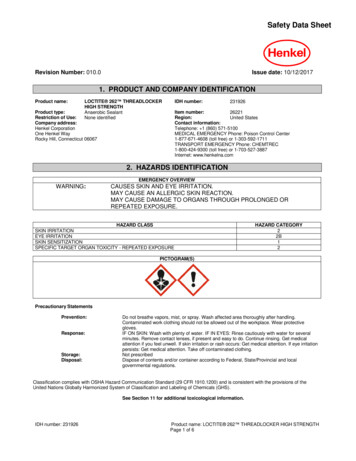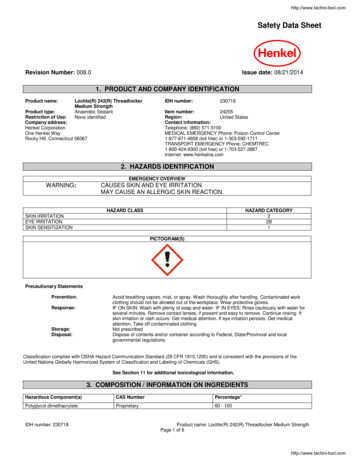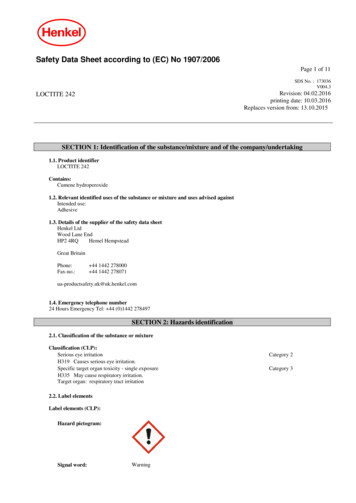
Transcription
Safety Data Sheet according to (EC) No 1907/2006Page 1 of 11SDS No. : 173036V004.3Revision: 04.02.2016printing date: 10.03.2016Replaces version from: 13.10.2015LOCTITE 242SECTION 1: Identification of the substance/mixture and of the company/undertaking1.1. Product identifierLOCTITE 242Contains:Cumene hydroperoxide1.2. Relevant identified uses of the substance or mixture and uses advised againstIntended use:Adhesive1.3. Details of the supplier of the safety data sheetHenkel LtdWood Lane EndHP2 4RQHemel HempsteadGreat BritainPhone:Fax-no.: 44 1442 278000 44 1442 278071ua-productsafety.uk@uk.henkel.com1.4. Emergency telephone number24 Hours Emergency Tel: 44 (0)1442 278497SECTION 2: Hazards identification2.1. Classification of the substance or mixtureClassification (CLP):Serious eye irritationH319 Causes serious eye irritation.Specific target organ toxicity - single exposureH335 May cause respiratory irritation.Target organ: respiratory tract irritation2.2. Label elementsLabel elements (CLP):Hazard pictogram:Signal word:WarningCategory 2Category 3
MSDS-No.: 173036V004.3LOCTITE 242Page 2 of 11Hazard statement:H319 Causes serious eye irritation.H335 May cause respiratory irritation.Precautionary statement:***For consumer use only: P101 If medical advice is needed, have product container orlabel at hand. P102 Keep out of reach of children. P501 Dispose of waste and residues inaccordance with local authority requirements***Precautionary statement:PreventionP261 Avoid breathing vapours.Precautionary statement:ResponseP337 P313 If eye irritation persists: Get medical advice/attention.2.3. Other hazardsNone if used properly.SECTION 3: Composition/information on ingredients3.2. MixturesGeneral chemical description:Anaerobic adhesive
MSDS-No.: 173036V004.3LOCTITE 242Page 3 of 11Declaration of the ingredients according to CLP (EC) No 1272/2008:Hazardous componentsCAS-No.Cumene hydroperoxide80-15-9EC NumberREACH-Reg No.201-254-7contentClassification1- 2,5 %Acute Tox. 4; DermalH312STOT RE 2H373Acute Tox. 4; OralH302Org. Perox. EH242Acute Tox. 3; InhalationH331Aquatic Chronic 2H411Skin Corr. 1BH314N,N-Diethyl-p-toluidine613-48-9210-345-00,1- 1 %Acute Tox. 3; OralH301Acute Tox. 3; DermalH311Acute Tox. 3; InhalationH331STOT RE 2H373Aquatic Chronic 3H4121,4-Naphthalenedione130-15-4204-977-60,01- 0,1 %Acute Tox. 3; OralH301Skin Irrit. 2; DermalH315Skin Sens. 1; DermalH317Eye Irrit. 2H319Acute Tox. 1; InhalationH330STOT SE 3; InhalationH335Aquatic Acute 1H400Aquatic Chronic 1H410M factor: 10For full text of the H - statements and other abbreviations see section 16 "Other information".Substances without classification may have community workplace exposure limits available.SECTION 4: First aid measures4.1. Description of first aid measuresInhalation:Move to fresh air. If symptoms persist, seek medical advice.Skin contact:Rinse with running water and soap.Obtain medical attention if irritation persists.Eye contact:Rinse immediately with plenty of running water (for 10 minutes), seek medical attention from a specialist.Ingestion:Rinse mouth, drink 1-2 glasses of water, do not induce vomiting, consult a doctor.
MSDS-No.: 173036V004.3LOCTITE 242Page 4 of 114.2. Most important symptoms and effects, both acute and delayedCauses serious eye irritation.RESPIRATORY: Irritation, coughing, shortness of breath, chest tightness.Prolonged or repeated contact may cause skin irritation.4.3. Indication of any immediate medical attention and special treatment neededSee section: Description of first aid measuresSECTION 5: Firefighting measures5.1. Extinguishing mediaSuitable extinguishing media:Carbon dioxide, foam, powderExtinguishing media which must not be used for safety reasons:None known5.2. Special hazards arising from the substance or mixtureIn the event of a fire, carbon monoxide (CO) and carbon dioxide (CO2) can be released.In case of fire, keep containers cool with water spray.Oxides of carbon, oxides of nitrogen, irritating organic vapors.5.3. Advice for firefightersWear self-contained breathing apparatus and full protective clothing, such as turn-out gear.SECTION 6: Accidental release measures6.1. Personal precautions, protective equipment and emergency proceduresAvoid skin and eye contact.Ensure adequate ventilation.6.2. Environmental precautionsDo not let product enter drains.6.3. Methods and material for containment and cleaning upFor small spills wipe up with paper towel and place in container for disposal.For large spills absorb onto inert absorbent material and place in sealed container for disposal.6.4. Reference to other sectionsSee advice in section 8SECTION 7: Handling and storage7.1. Precautions for safe handlingUse only in well-ventilated areas.Prolonged or repeated skin contact should be avoided to minimise any risk of sensitisation.Avoid skin and eye contact.See advice in section 8Hygiene measures:Good industrial hygiene practices should be observed.Do not eat, drink or smoke while working.Wash hands before work breaks and after finishing work.7.2. Conditions for safe storage, including any incompatibilitiesStore in original containers at 8-21 C (46.4-69.8 F) and do not return residual materials to containers as contamination mayreduce the shelf life of the bulk product.
MSDS-No.: 173036V004.3LOCTITE 242Page 5 of 117.3. Specific end use(s)AdhesiveSECTION 8: Exposure controls/personal protection8.1. Control parametersOccupational Exposure LimitsValid forGreat BritainIngredient [Regulated , IOL, TOTAL VAPOURAND PARTICULATES]mg/m3Value type10Time Weighted Average(TWA):EH40 WEL150474Time Weighted Average(TWA):EH40 WELppmmg/m3Value type10Time Weighted Average(TWA):IR OEL470Time Weighted Average(TWA):IR OELppmShort term exposure limitcategory / RemarksRegulatory listOccupational Exposure LimitsValid forIrelandIngredient [Regulated , 2-DIOL, TOTAL (VAPOURAND PARTICULATES)]Short term exposure limitcategory / RemarksRegulatory listBiological Exposure Indices:None8.2. Exposure controls:Engineering controls:Ensure good ventilation/extraction.Respiratory protection:Ensure adequate ventilation.An approved mask or respirator fitted with an organic vapour cartridge should be worn if the product is used in a poorlyventilated areaFilter type: A (EN 14387)
MSDS-No.: 173036V004.3LOCTITE 242Page 6 of 11Hand protection:Chemical-resistant protective gloves (EN 374).Suitable materials for short-term contact or splashes (recommended: at least protection index 2, corresponding to 30 minutespermeation time as per EN 374):nitrile rubber (NBR; 0.4 mm thickness)Suitable materials for longer, direct contact (recommended: protection index 6, corresponding to 480 minutes permeation timeas per EN 374):nitrile rubber (NBR; 0.4 mm thickness)This information is based on literature references and on information provided by glove manufacturers, or is derived by analogywith similar substances. Please note that in practice the working life of chemical-resistant protective gloves may be considerablyshorter than the permeation time determined in accordance with EN 374 as a result of the many influencing factors (e.g.temperature). If signs of wear and tear are noticed then the gloves should be replaced.Eye protection:Wear protective glasses.Protective eye equipment should conform to EN166.Skin protection:Wear suitable protective clothing.Protective clothing should conform to EN 14605 for liquid splashes or to EN 13982 for dusts.Advices to personal protection equipment:The information provided on personal protective equipment is for guidance purposes only. A full risk assessment should beconducted prior to using this product to determine the appropriate personal protective equipment to suit local conditions.Personal protective equipment should conform to the relevant EN standard.SECTION 9: Physical and chemical properties9.1. Information on basic physical and chemical our thresholdNo data available / Not applicablepH()Initial boiling pointFlash pointDecomposition temperatureVapour pressure(25 C (77 F))Vapour pressure(50 C (122 F))Density()Bulk densityViscosityViscosity (kinematic)Explosive propertiesSolubility (qualitative)(Solvent: Water)Solubility (qualitative)(Solvent: Acetone)Solidification temperatureMelting pointFlammabilityAuto-ignition temperatureExplosive limitsPartition coefficient: n-octanol/waterEvaporation rateVapor densityOxidising properties3-6 149 C ( 300.2 F) 100 C ( 212 F)No data available / Not applicable 0,1 mm hg 300 mbar1,08 g/cm3No data available / Not applicableNo data available / Not applicableNo data available / Not applicableNo data available / Not applicableNot miscibleMiscibleNo data available / Not applicableNo data available / Not applicableNo data available / Not applicableNo data available / Not applicableNo data available / Not applicableNo data available / Not applicableNo data available / Not applicableNo data available / Not applicableNo data available / Not applicable
MSDS-No.: 173036V004.3LOCTITE 242Page 7 of 119.2. Other informationNo data available / Not applicableSECTION 10: Stability and reactivity10.1. ReactivityReacts with strong oxidants.10.2. Chemical stabilityStable under recommended storage conditions.10.3. Possibility of hazardous reactionsSee section reactivity10.4. Conditions to avoidNo decomposition if used according to specifications.10.5. Incompatible materialsSee section reactivity10.6. Hazardous decomposition productsIrritating organic vapours.Oxides of carbon.SECTION 11: Toxicological information11.1. Information on toxicological effectsGeneral toxicological information:The mixture is classified based on the available hazard information for the ingredients as defined in the classification criteria formixtures for each hazard class or differentiation in Annex I to Regulation (EC) No 1272/2008. Relevant availablehealth/ecological information for the substances listed under Section 3 is provided in the following.STOT-single exposure:May cause respiratory irritation.Oral toxicity:This material is considered to have low toxicity if swallowed.Skin irritation:Prolonged or repeated contact may cause skin irritation.Eye irritation:Causes serious eye irritation.Acute oral toxicity:Hazardous componentsCAS-No.Cumene hydroperoxide80-15-9ValuetypeLD50Value550 mg/kgRoute ofapplicationoralExposuretimeSpeciesMethodratSkin corrosion/irritation:Hazardous componentsCAS-No.Cumene ciesMethodrabbitDraize Test
MSDS-No.: 173036V004.3LOCTITE 242Page 8 of 11Germ cell mutagenicity:Hazardous componentsCAS-No.ResultCumene hydroperoxide80-15-9positiveCumene hydroperoxide80-15-9negativeType of study /Route ofadministrationbacterial reversemutation assay (e.gAmes test)dermalMetabolicactivation /Exposure timewithoutSpeciesMethodOECD Guideline 471(Bacterial Reverse MutationAssay)mouseRepeated dose toxicityHazardous componentsCAS-No.ResultRoute ofapplicationCumene hydroperoxide80-15-9inhalation:aerosolExposure time /Frequency oftreatment6 h/d5 d/wSpeciesMethodratSECTION 12: Ecological informationGeneral ecological information:Cured Loctite products are typical polymers and do not pose any immediate environmental hazards.The mixture is classified based on the available hazard information for the ingredients as defined in the classification criteria formixtures for each hazard class or differentiation in Annex I to Regulation (EC) No 1272/2008. Relevant availablehealth/ecological information for the substances listed under Section 3 is provided in the following.12.1. ToxicityEcotoxicity:Do not empty into drains / surface water / ground water.Hazardous 3,9 mg/lAcuteToxicityStudyFishCumene hydroperoxide80-15-9LC5096 hOncorhynchus mykissCumene hydroperoxide80-15-9EC5018 mg/lDaphnia48 hCumene hydroperoxide80-15-9ErC503,1 mg/lAlgae72 hCumene 1070 mg/lBacteria30 minEC500,011 mg/lAlgae72 hOECD Guideline203 (Fish, AcuteToxicity Test)Daphnia magnaOECD Guideline202 (Daphnia sp.AcuteImmobilisationTest)Pseudokirchnerella subcapitata OECD Guideline201 (Alga, GrowthInhibition Test)Dunaliella bioculata12.2. Persistence and degradabilityPersistence and Biodegradability:The product is not biodegradable.Hazardous componentsCAS-No.ResultRoute ofapplicationMethodDegradabilityMethodOECD Guideline201 (Alga, GrowthInhibition Test)
MSDS-No.: 173036V004.3LOCTITE 242Page 9 of 11Cumene hydroperoxide80-15-9no data0%1,4-Naphthalenedione130-15-4no data0 - 60 %OECD Guideline 301 B (ReadyBiodegradability: CO2 EvolutionTest)OECD 301 A - F12.3. Bioaccumulative potential / 12.4. Mobility in soilMobility:Cured adhesives are immobile.Bioaccumulative potential:No data available.Hazardous componentsCAS-No.Cumene hydroperoxide80-15-9Cumene gKow Bioconcentration Exposurefactor D Guideline 305(Bioconcentration: Flowthrough Fish Test)2,161,7112.5. Results of PBT and vPvB assessmentNo data available.12.6. Other adverse effectsNo data available.SECTION 13: Disposal considerations13.1. Waste treatment methodsProduct disposal:Dispose of in accordance with local and national regulations.Contribution of this product to waste is very insignificant in comparison to article in which it is usedDisposal of uncleaned packages:After use, tubes, cartons and bottles containing residual product should be disposed of as chemically contaminated waste in anauthorised legal land fill site or incinerated.Waste code08 04 09 waste adhesives and sealants containing organic solvents and other dangerous substancesThe valid EWC waste code numbers are source-related. The manufac
MSDS-No.: 173036 V004.3 LOCTITE 242 Page 4 of 11 4.2. Most important symptoms and effects, both acute and delayed Causes serious eye irritation. RESPIRATORY: Irritation, coughing, shortness of breath, chest tightness. Prolonged or repeated contact may cause skin irritation. 4.3. Indication of any immediate medical attention and special treatment needed
